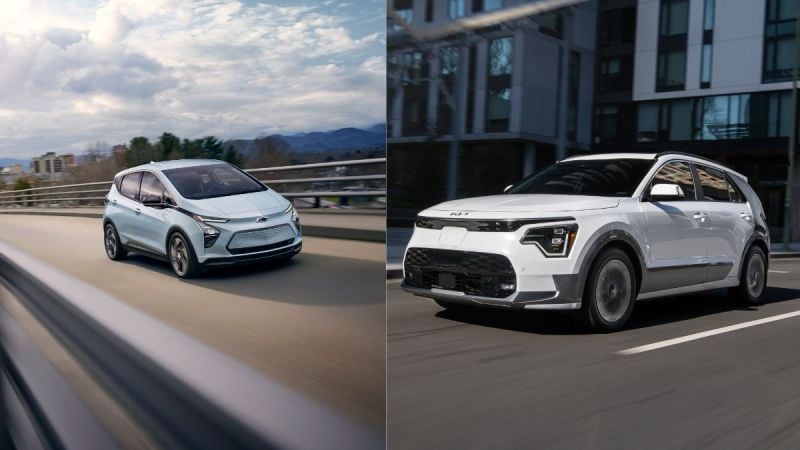In my last article on the Niro EV Wind, I described the differences in charging speeds, maximum range per full charge, and prices of the sub $40k EVs that are the Niro’s direct competitors. In my other write up on the Niro EV Wind, I reviewed the driving experience, as well as its interior comfort and spaciousness. A few weeks ago I also reported on which manufacturers were the top 5 EV sales leaders in the US last year and it turns out, of the half dozen or so EVs that cost less than $40k, the Niro likely sold the fewest. I don’t know if that was more due to price (and dealer markups) than availability, though I am sure it is some combination of both because there was at least one month when almost no Niros were sold in the US I also wonder if perhaps Kia is electing not to capitalize on the Niro’s strengths (especially its standard safety features) in its marketing of the Niro. In any case, whatever the reasons are that fewer people chose the Niro than all the other widely available EVs with base model MSRPs under $40k, that may no longer be the case with the 2023 models now on sale given the appealing redesign and standard feature set in the Niro EV.
First, let’s compare the feature sets in the base model Chevy Bolt and EUV to the base Niro EV. And in doing this we must turn immediately to the huge advantage that the Niro has over the Chevy Bolt when comparing base models: standard safety features. The base Bolts come standard with: HD Rear Vision Camera, OnStar Connected Services capability, StabiliTrak electronic stability and traction control, LED daytime running lamps with sequential turn signals, 3 Years of Remote Access, Pedestrian Safety Signal (something all EVs are required to include), Tire Fill Alert and Pressure Monitoring System, and Teen Driver. I don’t know about you, but a couple of those features aren’t worth calling out because they are required features or simply not that useful or, like the Tire Fill Alert, which makes noise when the proper pressure is reached during inflation, hardly seems like a safety feature and is something just as easily done with a pressure gauge. The Niro has similar features for nearly all of these that Chevy lists, and yet it also has a lot more. The Niro’s standard safety features also include: Forward Collision-Avoidance Assist w/ Pedestrian, Cyclist & Junction Turning Detection, Blind-Spot Collision-Avoidance Assist, Rear Cross-Traffic Collision-Avoidance Assist, Lane Keeping and Following Assist, Rear Parking Sensors, Driver Attention Warning w/ Leading Vehicle Departure Alert, Safe Exit Warning, Highway Driving Assist, Intelligent Speed Limit Assist, Hill-Start Assist Control, Downhill Brake Control and last but not least Smart Cruise Control w/ Stop & Go. In my mind, this long list of additional standard safety features goes a long way to make up the roughly $11,000 difference between base models. But that certainly isn’t all; the Kia Niro has a longer standard warranty (5 years/60,000 miles bumper to bumper, 10 years/100,000 miles on powertrain and battery) than Chevy does (3 year/36,000 mile bumper to bumper, 8 years/100,000 miles on powertrain and battery). Kia also has more passenger and cargo room than either Bolt does, a heated windshield feature, automatic rain sensing wipers, and powered driver’s seat adjustments too. So for the extra money, Kia is at least giving us a lot more features we might enjoy or want. Does that make it worth it to you? Note, to get some (not all) of these additional features that the Niro just comes with in the Bolts, one has to select a higher trim and additional packages, raising the price to around $32k for the standard Bolt.
This isn’t to say that Kia shouldn’t try to bring down their prices a little if they want to be more competitive (or perhaps cram in more features like all wheel drive or an extra 30 miles of range). It’s just worth pointing out that Kia offers a lot of standard features and people may not realize exactly what they are getting for the higher price.
Would you be more interested in the Niro knowing that its standard feature set was better than other EVs it competes with? Stay tuned for follow up pieces where I’ll compare the base model features of the other EVs starting under $40k to the Niro as well. As always, please leave any questions or comments below.
Images courtesy of Kia and Chevrolet.
Justin Hart has owned and driven electric vehicles for over 15 years, including a first generation Nissan LEAF, second generation Chevy Volt, Tesla Model 3, an electric bicycle and most recently a Kia Sorento PHEV. He is also an avid SUP rider, poet, photographer and wine lover. He enjoys taking long EV and PHEV road trips to beautiful and serene places with the people he loves. Follow Justin on Twitter for daily KIA EV news coverage.












